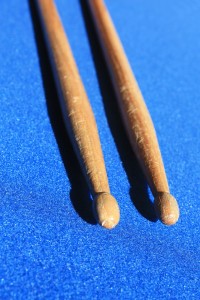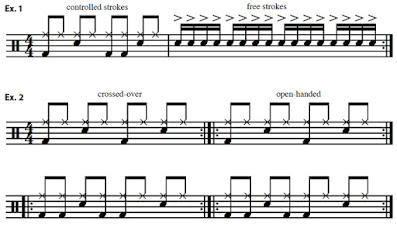STICKS
Drumsticks aren’t overly mystifying, yet there is information that you should be able to draw from when choosing a particular size or model. Here are some of the questions you might be asking.
What do the numbers and letters mean?
The history behind the numbers and letters stamped on drumsticks is a little foggy. The letters originally stood for styles of music, while the number was related to the stick’s diameter. The larger the diameter, the lower the number. Some of this coding still applies to today’s basic stick models. Here’s a breakdown of what the companies used back in the early 1900s, when this system was first established:
The letter A stood for orchestra.
The letter B stood for marching and concert bands.
The letter S stood for street band.
The letter D, used by Gretsch, stood for dance band.
2B is the most common size for a thick stick.
7A is the most common size for a thin stick.
Most stick manufacturers still offer the classic models: 2B, 5A, 5B, and 7A. As Pat Brown of Promark puts it, “Beyond that, most companies have adopted their own individual systems for naming or numbering sticks, and usually those names or numbers are little more than generic part numbers that bear little or no relevance to the size or shape of the stick.” So in order to keep your customers from getting overwhelmed by the options as they search for the right stick, consider having pairs in the basic sizes nearby to help guide you in the right direction.
What’s the difference between sticks made of hickory, maple, oak, and plastic?

The most common types of wood used today are hickory and maple. Maple is 10 percent lighter than hickory, which allows drummers to use a larger-diameter stick without it being too heavy. Maple also plays a bit faster. It wears out pretty quickly, however. Hickory is a harder wood and will last longer than maple. Hickory is also fairly resilient and can absorb the shock of a hard-hitting drummer. Oak is the heaviest wood option. Promark’s Japanese Shira Kashi white oak sticks are 10 percent heavier than those made with American hickory. The extra density means oak sticks can withstand more intense playing styles.
The bottom line is that oak will last the longest. Hickory has a natural feel, takes an average amount of punishment, and is the most versatile of the three wood types. Maple will allow for more sensitivity and may be better suited to lighter playing situations.
For extreme durability, check out the aluminum/ plastic sticks by Ahead. These drumsticks are made of aerospace-grade aluminum tubing, and the upper half has a replaceable polyurethane cover with a threaded tip. These sticks are designed to last, while still offering a comfortable playing experience. According to Ahead, “Our sticks have up to 50 percent less shock and can last up to ten times longer than most similarly sized wood models.”
Hickory is of medium weight and durable.
Maple is lightweight and quick.
Oak is heavyweight and durable.
Aluminum/polyurethane sticks provide extra rebound and are extremely durable.
How does the stick’s tip shape affect the sound?
There are five basic shapes of drumstick tips, and each one produces a different sound and has a different feel, especially when it comes to playing cymbals.
Oval: largest spectrum of sound
Teardrop: warm with focused low tones
Round/ball: clean, bright, and crisp
Acorn: full, rich, and fat
Barrel: punchy and loud
When choosing sticks, consider the type of music you play. Do you need to be heard over a couple of Marshall amps? If so, a barrel-style nylon-tip model could work best.
What’s the difference between wood and nylon tips?
According to Mark Dyke at Vic Firth, “The drummer will choose between a wood- and nylon-tip stick based on the desired sound color of the cymbal. Nylon tips create a brighter sound than wood.” Also, nylon tips are virtually indestructible, so nylon tips will far outlast wood tips. Regal Tip’s unique E series nylon tip is designed to offer the durability of plastic with the warmer sound of wood.
Nylon: long-lasting tip, bright sound
Wood: full and warm sound
Regal Tip E series: durable tip, warm sound

What effect does lacquering have on the sticks?
Lacquer seals the wood and stabilizes moisture content. It can also help provide a more comfortable grip. Regal Tip’s three-step lacquer process is designed to take the comfort level one step higher. According to Regal Tip’s Carol Calato, “This lacquer finish will actually get a slight tacky feel when your hand heats up as you play.”
Some lacquers are too thick for certain drummers; those players will need a model that’s closer to raw wood. If your hands sweat very easily, a stick with a lot of lacquer can be very difficult to hold on to. A “specialty grip” stick may be the best choice; these models feature non-slip coating toward the butt end.
Lacquered: slick feel, moisture resistant
Unlacquered: tight grip, susceptible to moisture-content changes
Grip stick: no slippage, moisture resistant
What’s the best size and model for a beginner?
One size does not fit all. If a student has small hands (either because of age or stature), the most logical recommendation would be a smaller stick than one used by someone with a larger hand. But some experimentation is required to find what feels most comfortable. A 7A is a good choice for someone with small hands, like a young student. A 5A is the most common model for average-size teenage or adult hands. Some companies offer a stick that is specifically made to fit the small hands of a young drummer. Those include Vic Firth’s SD 1 Jr., Vater’s Junior Sticks, and Promark’s SD1F Future Pro.
Consider the size of your hand, and play a couple of hits on a rubber pad using different sticks. If the stroke looks a bit out of control with a thin stick, try a thicker model. Control is everything for a beginning drummer, and finding the correct size of stick is a crucial element in developing proper technique.
Choosing the best drum sticks as a jazz player is no simple task. The number of different factors to consider- stick size, material, head shape, taper length, more- is headache-inducing. Not to mention that naming conventions are archaic and confusing (higher numbers mean thinner sticks, for example.) But read on for a breakdown that should clear the air.
Stick Size
Stick naming conventions actually have a pretty interesting history. They consist of a number and letter. As I mentioned earlier, the higher the number, the thinner the stick. And the letters were A for orchestras, B for marching bands, or D for dance bands. Yes, that convention has somehow stuck around despite being hopelessly out-of-date. It’s helpful to just recognize a few very common sizes. The most all-around, or even “typical” size is 5A. It’s a great size for beginners, and can be adapted to pretty much any genre, jazz included. 7A sticks are among the thinnest and lightest, and usually the top recommendation for jazz players. On the other end of the spectrum, 2B sticks are massive, preferred by very heavy players in genres like rock and metal.
Since jazz tends to be softer and more dynamic, thinner sticks like 7A shine. The light weight makes them more prone to breaking, which is why other genres with heavier playing go for more substantial sticks. But the lighter sticks are also more expressive and lighter on your hands.
Stick Material
The three most popular wood types are maple, hickory, and oak. These three form a spectrum from the lightest to heaviest material. Many jazz players prefer maple sticks, which are very light and flexible. The flexibility also means they absorb the most energy, making them the easiest on your hands. So 7A maples are a common recommendation for jazz players.
On the other hand, oak sticks are the heaviest and densest. Oak absorbs the least energy and is therefore harder on your hands. It’s also the most durable. Hickory is the middle ground between these materials.
Tip Material
Drum sticks usually have wood or nylon tips. Wood is the default and the most common. This gives a deeper, richer, fuller, and more organic tone. On the other hand, nylon-tipped sticks are known to be great for very bright, sharp, well-defined cymbal work.
Tip Shape
There are at least a half-dozen tip shapes, and to make matters worse, their names are inconsistent. Tip shape also has a subjective, difficult-to-describe effect on tone. Teardrop tips are the most common, and very adaptable and comfortable across styles. But my jazz stick recommendations run the gamut of tip shapes, so this seems to be one of the most subjective aspects of stick choice.
Choosing the Best Sticks for You
Understanding the different aspects of drum stick design only gets you so far. Because while many players play jazz with conventionally jazz-oriented sticks, others are known to play with sticks that belong in a punk or metal band. There’s no substitute for trying out different kinds of sticks and seeing what suits your playing style and kit the best. The work is worthwhile- once you find “your sticks” you are likely to stick with them (no pun intended) for a very long time. Combing some drummer forums and other articles though, I saw veterans consistently recommending some of the same models. I’m sure these are the best places to start!
Another note: I highly recommend buying from a trusted brand like Vic Firth, Zildjian, or others, over lower-cost and lesser-known brands. Sure, you pay a premium, but it’s not just for brand-name markup. The trusted brands built their reputation on quality control and testing. They actually put the work into making sure each individual stick is very well-made, and pairing the sticks proficiently.


Σχόλια
Δημοσίευση σχολίου